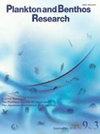Estimation of production of the copepod Calanus sinicus during spring in the northern East China Sea
IF 0.9
4区 生物学
Q4 MARINE & FRESHWATER BIOLOGY
引用次数: 1
Abstract
We estimated the production of the copepod Calanus sinicus, including somatic production of copepodite stage 1 (CI) to copepodite stage 5 (CV) and egg production of adult females, to elucidate the role of C. sinicus during spring in the northern East China Sea, including the southern waters of Korea. To estimate the somatic production of the copepodites, an empirical equation for broadcasters (Hirst & Bunker 2003) was used. The total biomass of the C. sinicus population, including CI to adult males and females, ranged from 0.11 to 30.23 mg C m−3, with a mean of 8.69 mg C m−3. The egg production rate (EPR) of adult females of C. sinicus, measured over 24 h of shipboard incubation, ranged from 0 to 14.9 eggs female−1 day−1 (mean 5.8 eggs female−1 day−1), equivalent to mean 33.6 μg C m−3 day−1. The weight-specific EPR (WSEPR) of adult females averaged 0.023 day−1, and significantly increased with increasing water temperature at 5 m depth and surface chlorophyll a concentration, respectively. WSEPR decreased with increasing body mass of individual adult females. The total production of the C. sinicus population ranged from 0.02 to 3.67 mg C m−3 day−1 (mean 0.91 mg C m−3 day−1) and the depth-integrated mean total production was estimated to be 52.72 mg C m−2 day−1. CV production accounted for 54% of the total production. By contrast, EPR contributed on average only 3.7% of the total production rate. Our estimate of the production of C. sinicus can be applied for potential comparisons of region-specific copepod production.东海北部春季桡足类鱿鱼产量的估算
为了阐明中国东海北部(包括朝鲜南部海域)春季桡足类黄鳝(Calanus sinicus)的作用,我们对黄鳝(Calanus sinicus)的产量进行了估算,包括桡足类第1期(CI)至桡足类第5期(CV)的体产量和成虫产卵量。为了估计桡足动物的体细胞产量,使用了广播公司的经验方程(Hirst & Bunker 2003)。黄颡鱼种群总生物量(雄性和雌性)为0.11 ~ 30.23 mg C m−3,平均为8.69 mg C m−3。在船上孵育24 h后,成虫产卵率(EPR)为0 ~ 14.9个雌卵(平均5.8个雌卵),相当于平均33.6 μ C m−3 day−1。雌成虫体重比EPR (WSEPR)平均为0.023 d−1,随5 m水深温度和表面叶绿素a浓度的升高而显著升高。WSEPR随个体体重的增加而降低。sinicus种群的总产量为0.02 ~ 3.67 mg C m−3 day−1(平均为0.91 mg C m−3 day−1),深度综合的平均总产量为52.72 mg C m−2 day−1。CV产量占总产量的54%。相比之下,EPR平均只占总产量的3.7%。我们对黄曲霉产量的估计可以用于区域特定桡足类产量的潜在比较。
本文章由计算机程序翻译,如有差异,请以英文原文为准。
求助全文
约1分钟内获得全文
求助全文
来源期刊

Plankton & Benthos Research
Agricultural and Biological Sciences-Aquatic Science
CiteScore
1.30
自引率
0.00%
发文量
32
期刊介绍:
Plankton and Benthos Research is a peer-reviewed journal publishing quarterly original papers, reviews and notes dealing with any aspect of the biology and ecology of planktonic and benthic organisms and their interactions with the environment in any aquatic system, and is open to all scientists around the world. Submission of a paper is held to imply that it represents an original contribution not previously published and that it is not being considered elsewhere.
 求助内容:
求助内容: 应助结果提醒方式:
应助结果提醒方式:


